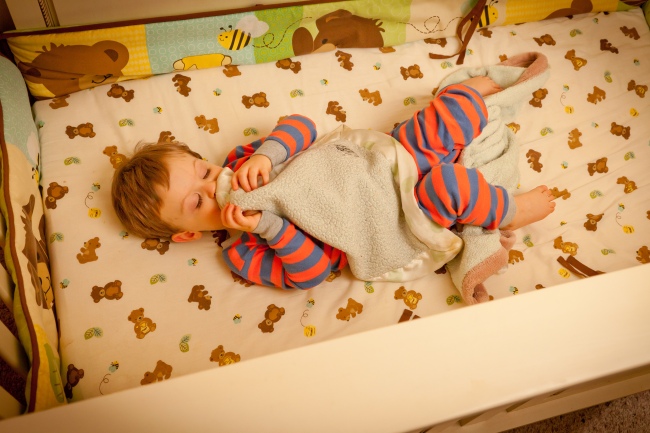
In this article, I am going to cover why naptime for toddlers is so important, and some tips to help you create a no-nonsense routine for your child. Let’s get started!
While going through the training process to become a Certified Child Sleep Consultant, I learned that bedtime is non-negotiable; naptime should be treated the same way. I often have clients who tell me that their toddler decided they do not want to nap anymore. My response to them is that as the parent, you decide when naps will end, not your child.
Inconsistencies are a part of parenthood. However, a regular sleep routine is a different story. Once a child has their normal sleep schedule ironed out, this is when exceptions can be made and once in a while a nap can be skipped for a special occasion.
Naptime For Toddlers And The Science of Sleep
Let’s get the scientific facts out of the way. Infants nap throughout the day and there is a reason for this. Naps effect night sleep and vice versa. Think of naps as part of the 24 hour daily sleep cycle. When a child outgrows the infant stage and becomes a toddler, this doesn’t change. Naptime for toddlers remains an important piece of the sleeping puzzle.
Naps allow the body and mind to rest and provide both mental and physical restoration. The benefits to a healthy sleep routine are endless. A child with a regular naptime and bedtime, based on biological sleep waves will be focused, happy, and of course, well-rested. What we have learned through studies and research is that healthy sleep during childhood, has an impact on our adult behavior and cognitive ability, as well as our concentration and mood.
If you are a parent reading this blog and wondering if your child should still be napping, I encourage you to ask yourself this; “What is my child’s behavior like at the end of the day?” We often hear parents make remarks about their child acting cranky, stubborn or having behavior issues and they attribute it to their child being tired. This is not the case for a rested child. Appropriate behavior is exhibited by a child who is getting adequate amounts of sleep, both day and night. Cranky behavior is not just something to brush off, as a parent we need to figure out the cause behind it.
One of my philosophies about child sleep is that parents need to enter into each developmental stage as prepared as possible, so that they don’t have to go back and correct behavior. Small but constant deficits in sleep over time tend to have escalating and perhaps long-term effects on brain function. Over many weeks or months, your child develops ‘cumulative sleepiness’ until he hits a wall and becomes overtired. In this state, it is difficult for him to nap because his body is geared up to fight the fatigue. If you do not give your child the option to skip a nap, then you will not have to figure out how to get them to start napping again.
My intentions are not to scare parents with toddlers who do not nap, or to make them feel guilty. My intention is to give them the facts so that they can understand that sleep needs to be one of the highest priorities of parenting.
Parents of toddlers who give in to their child’s refusal to nap are not intentionally delaying their mental and physical development. Parents do not influence negative sleep habits on purpose. That’s where I come in, part of my job is to educate parents on the benefits of a healthy sleep schedule so that they understand why and how sleep positively influences their child today and in the future.
I really can’t emphasize enough how important a consistent nap routine is for a toddler. Sleep Inertia experience by a child is just one result of disturbed sleep. It can be explained as the intermittent state where sleep and wakefulness overlap. This overlap state is uncomfortable for children and causes disorientation as well as physical pain. Parents are often confused when their child wakes from an extra-long nap unhappy. The simple answer is your child has been missing too much sleep. Also, if you are experiencing a child who is “wired” and not able to entertain themselves, it is because the high cortisol levels produced in their body after missing a sleep period makes the child too tired to nap. “A sign of sleeping well is a calm and alert state. Upon awakening, well rested children are in good cheer and able to play by themselves.”
As this post on naptime for toddlers is coming to an end I leave you with one thought, “It is simply not true that children who miss naps will “make up” for it by sleeping more at night. In fact the sleep they miss is gone forever.”
Weissbluth, Marc. Healthy Sleep Habits, Happy Child: A Step-by-step Program for a Good Night’s Sleep. New York: Ballantine Books, 2005
As seen on “Growing Up Madison” January 2014


Comments 12
Pingback: kamagra následující den codexex
Pingback: online order xifaxan generic pricing
Pingback: india prescription drugs avodart
Pingback: buying itraconazole buy online australia
Pingback: low price gabapentin from Canada
Pingback: how to get fildena prescription on line
Pingback: online order flexeril cyclobenzaprine cheap from usa
Pingback: how to buy dutasteride without prescriptions uk
Pingback: ordering enclomiphene purchase online uk
Pingback: acheter kamagra ordonnance pilule
Pingback: how to order rifaximin france where to buy
Pingback: cod saturday androxal